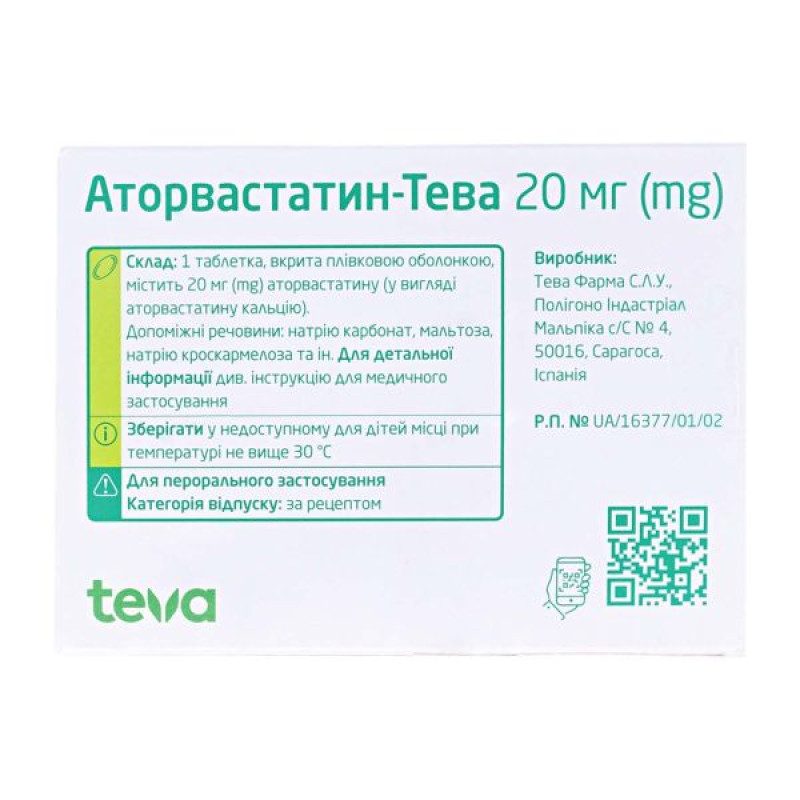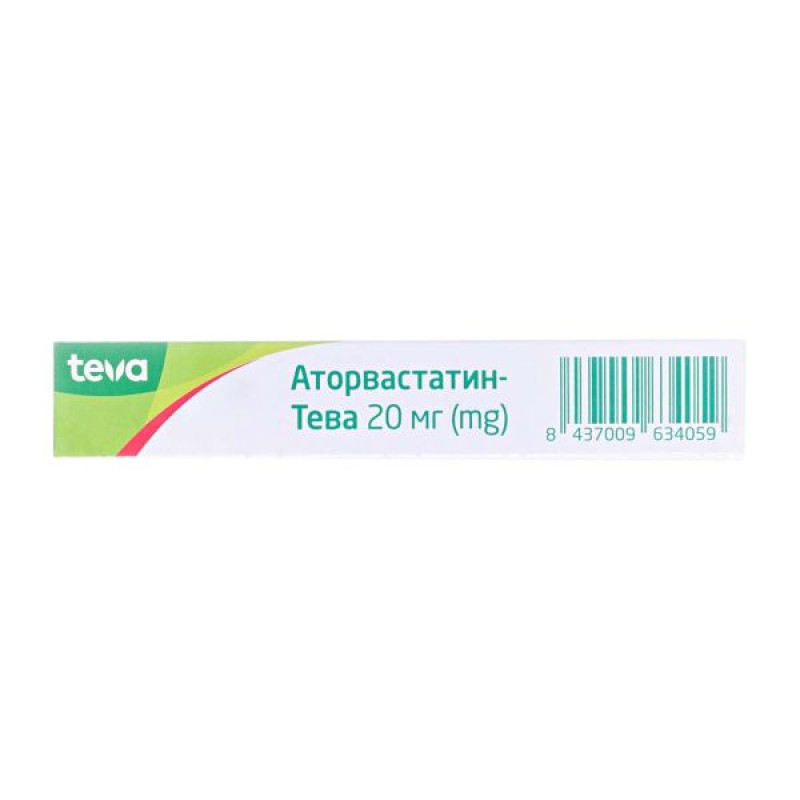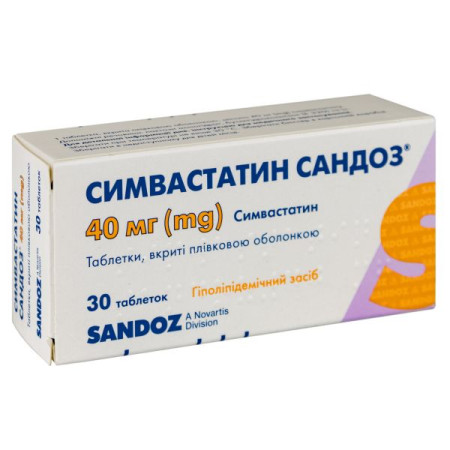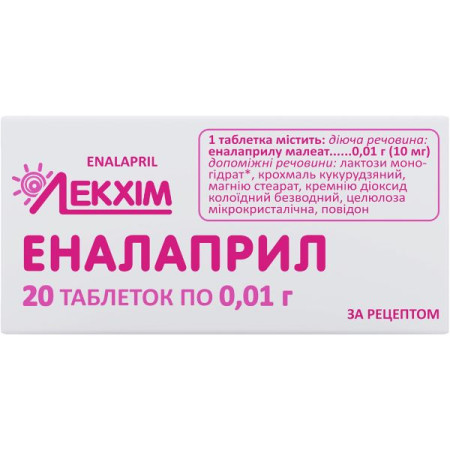Atorvastatin-Teva film-coated tablets 20 mg blister No. 30
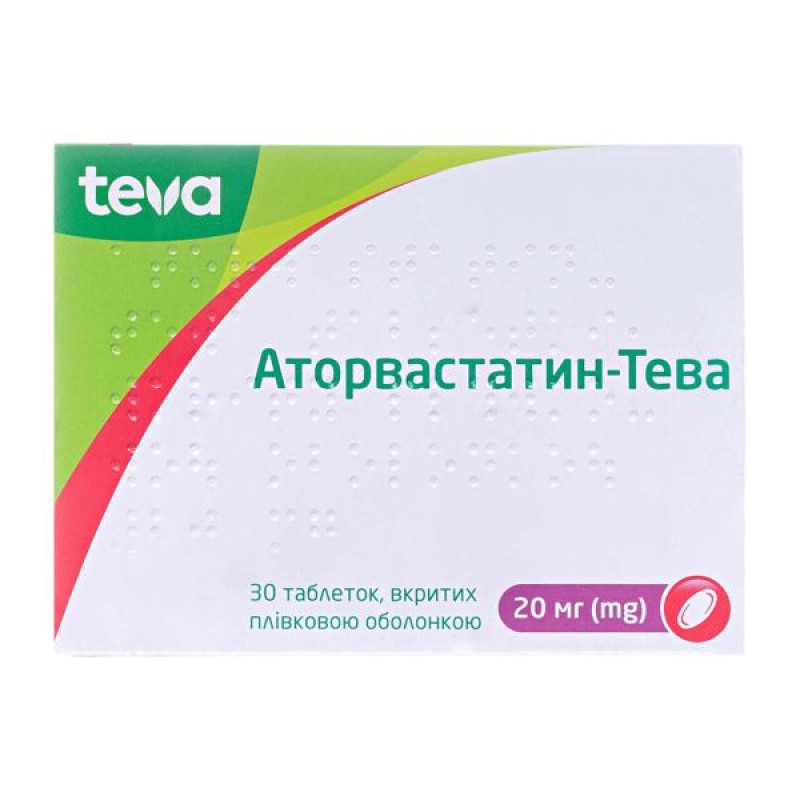
Instructions for Atorvastatin-Teva film-coated tablets 20 mg blister No. 30
Composition
active ingredient: atorvastatin;
1 film-coated tablet contains 10 mg or 20 mg, or 40 mg, or 80 mg of atorvastatin (as atorvastatin calcium);
excipients:
core: microcrystalline cellulose, sodium carbonate, maltose, croscarmellose sodium, magnesium stearate;
shell: hypromellose (E 464), hydroxypropylcellulose, triethyl citrate (E 1505), polysorbate 80, titanium dioxide (E 171).
Dosage form
Film-coated tablets.
Main physicochemical properties: white or almost white, elliptical, biconvex, smooth tablets, approximately
12.5 mm × 6.6 mm.
Pharmacotherapeutic group
Drugs that lower serum cholesterol and triglyceride levels. HMG-CoA reductase inhibitors. ATX code C10A A05.
Pharmacological properties
Pharmacodynamics
Atorvastatin is a selective competitive inhibitor of HMG-CoA reductase, an enzyme that regulates the rate of conversion of 3-hydroxy-3-methylglutaryl-coenzyme A to mevalonate, a precursor of sterols, including cholesterol. Cholesterol and triglycerides circulate in the bloodstream complexed with lipoproteins. These complexes are separated by ultracentrifugation into HDL (high-density lipoprotein), LDL (intermediate-density lipoprotein), LDL (low-density lipoprotein), and VLDL (very-low-density lipoprotein) fractions. Triglycerides (TG) and cholesterol in the liver are incorporated into VLDL and released into the blood plasma for transport to peripheral tissues. LDL is formed from VLDL and catabolized by interaction with high-affinity LDL receptors. Clinical and pathological studies show that elevated plasma levels of total cholesterol (TC), LDL-cholesterol (LDL-C), and apolipoprotein B (apo B) contribute to the development of atherosclerosis in humans and are risk factors for cardiovascular disease, while elevated HDL-cholesterol levels are associated with a reduced risk of cardiovascular disease.
Atorvastatin lowers plasma cholesterol and lipoprotein levels by inhibiting hepatic HMG-CoA reductase and cholesterol synthesis and by increasing the number of hepatic LDL receptors on the cell surface to enhance uptake and catabolism of LDL; atorvastatin also reduces LDL production and particle size. Atorvastatin reduces LDL cholesterol in some patients with homozygous familial hypercholesterolemia, a group of people who rarely respond to treatment with other lipid-lowering drugs.
Numerous clinical studies have shown that elevated levels of total cholesterol, LDL cholesterol, and apo B (the membrane complex for LDL cholesterol) are associated with the development of atherosclerosis. Similarly, low levels of HDL cholesterol (and its transport complex, apo A) are associated with the development of atherosclerosis. Epidemiological studies have shown that cardiovascular morbidity and mortality vary directly with total cholesterol and LDL cholesterol levels and inversely with HDL cholesterol levels.
Atorvastatin reduces total cholesterol, LDL-cholesterol, and apo B in patients with homozygous and heterozygous familial hypercholesterolemia, nonfamilial hypercholesterolemia, and mixed dyslipidemia. Atorvastatin also reduces VLDL-cholesterol and TG, and causes transient increases in HDL-cholesterol and apolipoprotein A-1. Atorvastatin reduces total cholesterol, LDL-cholesterol, VLDL-cholesterol, apo B, triglycerides, and non-HDL-C, and increases HDL-C in patients with isolated hypertriglyceridemia. Atorvastatin reduces LDL-C in patients with dysbetalipoproteinemia.
Like LDL, cholesterol- and triglyceride-rich lipoproteins, including VLDL, HDL, and remnants, may also contribute to atherosclerosis. Elevated plasma triglyceride levels are often found in the triad of low HDL-C and small LDL particles, and in association with nonlipid metabolic risk factors for coronary heart disease. Total plasma triglycerides per se have not been consistently shown to be an independent risk factor for coronary heart disease. Furthermore, no independent effect of increasing HDL or decreasing triglycerides on the risk of coronary and cardiovascular morbidity and mortality has been established.
Atorvastatin, as well as some of its metabolites, are pharmacologically active in humans. The main site of action of atorvastatin is the liver, which plays a major role in cholesterol synthesis and LDL clearance. The dose of the drug, in contrast to the systemic concentration of the drug, correlates better with the reduction in LDL cholesterol levels. Individual selection of the dose of the drug should be carried out depending on the therapeutic response (see section "Method of administration and dosage").
Pharmacokinetics
Atorvastatin is rapidly absorbed after oral administration, with peak plasma concentrations occurring within 1–2 hours. The extent of absorption increases proportionally to the dose of atorvastatin. The absolute bioavailability of atorvastatin (parent drug) is approximately 14%, and the systemic bioavailability of HMG-CoA reductase inhibitory activity is approximately 30%. The low systemic availability of the drug is attributed to presystemic clearance in the gastrointestinal mucosa and/or presystemic biotransformation in the liver. Although food reduces the rate and extent of absorption of the drug by approximately 25% and 9%, respectively, based on Cmax and AUC, the reduction in LDL-C is similar whether atorvastatin is taken with or without food. When atorvastatin was administered in the evening, its plasma concentration was lower (approximately 30% for Cmax and AUC) than when administered in the morning. However, the reduction in LDL-C was the same regardless of the time of administration (see section 4.2).
Distribution
The mean volume of distribution of atorvastatin is approximately 381 liters. More than 98% of the drug is bound to plasma proteins. The blood/plasma concentration ratio of approximately 0.25 indicates poor penetration of the drug into erythrocytes. Based on observations in rats, it is believed that atorvastatin is able to penetrate into breast milk (see sections "Contraindications", "Use during pregnancy or lactation" and "Special instructions").
Metabolism
Atorvastatin is extensively metabolized to ortho- and parahydroxylated derivatives and various beta-oxidation products. In vitro studies have shown that the inhibition of HMG-CoA reductase by ortho- and parahydroxylated metabolites was equivalent to that of atorvastatin. Approximately 70% of the circulating inhibitory activity against HMG-CoA reductase is associated with the active metabolites. In vitro studies suggest the importance of atorvastatin metabolism by cytochrome P450 3A4, which is consistent with the increased plasma concentrations of atorvastatin in humans after concomitant administration with erythromycin, a known inhibitor of this isoenzyme (see section 4.5).
Excretion
Atorvastatin and its metabolites are eliminated primarily in the bile after hepatic and/or extrahepatic metabolism, but the drug does not appear to undergo enterohepatic recirculation. The mean elimination half-life of atorvastatin from human plasma is approximately 14 hours, but the half-life of HMG-CoA reductase inhibitory activity is 20 to 30 hours due to the contribution of active metabolites. Less than 2% of the dose is excreted in the urine after oral administration.
Patient populations
Elderly: Plasma concentrations of atorvastatin are higher (approximately 40% for Cmax and 30% for AUC) in healthy elderly subjects (aged 65 years and older) than in young adults. Clinical data suggest that at any dose, atorvastatin is more effective in reducing LDL-C in elderly subjects than in young subjects (see section 4.4).
Children: Pharmacokinetic data on pediatric patients are not available.
Gender: Plasma concentrations of atorvastatin in women differ from those in men (Cmax is approximately 20% higher, AUC is approximately 10% lower). However, there is no clinically significant difference in LDL-C reduction between men and women with atorvastatin.
Renal impairment: Renal disease has no effect on atorvastatin plasma concentrations or LDL-C reduction, and therefore no dose adjustment is required in patients with renal impairment (see Dosage and Administration, Precautions).
Hemodialysis: Although studies have not been conducted in patients with end-stage renal disease, hemodialysis is not expected to significantly increase the clearance of atorvastatin because the drug is highly bound to plasma proteins.
Hepatic impairment. Plasma concentrations of atorvastatin are markedly increased in patients with chronic alcoholic liver disease. Cmax and AUC values are 4-fold higher in patients with Child-Pugh Class A liver disease. In patients with Child-Pugh Class B liver disease, Cmax and AUC values are increased approximately 16-fold and 11-fold, respectively (see Contraindications).
Indication
Prevention of cardiovascular disease
In adult patients without clinically evident coronary heart disease but with multiple risk factors for coronary heart disease, such as age, smoking, hypertension, low HDL, or a family history of early coronary heart disease, atorvastatin is indicated for:
reducing the risk of myocardial infarction; reducing the risk of stroke; reducing the risk of the need for revascularization procedures and angina.
reducing the risk of myocardial infarction; reducing the risk of stroke.
In patients with clinically significant coronary heart disease, Atorvastatin-Teva is indicated for:
reduced risk of non-fatal myocardial infarction; reduced risk of fatal and non-fatal stroke; reduced risk of need for revascularization procedures; reduced risk of need for hospitalization for congestive heart failure; reduced risk of angina.
Hyperlipidemia
As an adjunct to diet to reduce elevated total cholesterol, LDL-cholesterol, apolipoprotein B and triglycerides and to increase HDL-cholesterol in patients with primary hypercholesterolemia (heterozygous familial and non-familial) and mixed dyslipidemia (Fredrickson types IIa and IIb). As an adjunct to diet to treat patients with elevated serum triglycerides (Fredrickson type IV). For the treatment of patients with primary dysbetalipoproteinemia (Fredrickson type III) when diet is inadequate. To reduce total cholesterol and LDL-cholesterol in patients with homozygous familial hypercholesterolemia as an adjunct to other lipid-lowering treatments (e.g. LDL apheresis) or when such treatments are unavailable. As an adjunct to diet to reduce total cholesterol, LDL-cholesterol and apolipoprotein B levels in boys and girls (postmenarcheal) aged 10 to 17 years with heterozygous familial hypercholesterolemia, if, after appropriate diet therapy, the test results are as follows:
a) LDL cholesterol remains ≥ 190 mg/dL or
b) LDL cholesterol ≥ 160 mg/dL and:
There is a family history of early cardiovascular disease or two or more other risk factors for cardiovascular disease are present in the patient as a child.
Contraindication
Hypersensitivity to any of the components of the drug.
Active liver disease or persistent elevation of hepatic transaminase levels of unknown etiology, three times the upper limit of normal.
Use of the antiviral drug glecaprevir/pibrentasvir for the treatment of hepatitis C.
Pregnancy and breastfeeding.
Contraindicated in women of reproductive age who are not using contraceptives.
Interaction with other medicinal products and other types of interactions
The risk of myopathy during statin treatment is increased by concomitant use of fibric acid derivatives, lipid-modifying doses of niacin, cyclosporine, or potent CYP3A4 inhibitors (e.g. clarithromycin, HIV protease inhibitors, and itraconazole) (see sections 4.4 and 5.1).
Potent CYP3A4 inhibitors. Atorvastatin is metabolized by cytochrome P450 3A4 and is a substrate for the hepatic transporters organic anion transporting polypeptide 1B1 (OATP1B1) and 1B3 (OATP1B3). Atorvastatin metabolites are substrates of OATP1B1. Atorvastatin has also been identified as a substrate for multidrug resistance protein 1 (MDR1) and breast cancer resistance protein (BCRP), which may limit intestinal absorption and biliary clearance of atorvastatin.
Moderate CYP3A4 inhibitors (e.g. erythromycin, diltiazem, verapamil and fluconazole) may increase plasma concentrations of atorvastatin (see Table 2). Concomitant use of erythromycin and statins is associated with an increased risk of myopathy. Drug interaction studies to evaluate the effects of amiodarone or verapamil on atorvastatin have not been conducted. Amiodarone and verapamil are known to inhibit CYP3A4 activity, and therefore, co-administration of these drugs with atorvastatin may result in increased exposure to atorvastatin. Therefore, lower maximum doses of atorvastatin should be considered when atorvastatin is co-administered with these moderate CYP3A4 inhibitors. Clinical monitoring of the patient is also recommended. Clinical monitoring of the patient is recommended after initiation of treatment with an inhibitor or after dose adjustment.
Grapefruit juice contains one or more components that inhibit CYP3A4 and may increase plasma concentrations of atorvastatin, especially with excessive grapefruit juice consumption (more than 1.2 L per day).
Clarithromycin: Atorvastatin AUC was significantly increased when atorvastatin 80 mg was co-administered with clarithromycin (500 mg twice daily) compared to atorvastatin alone. Therefore, atorvastatin doses above 20 mg should be used with caution in patients taking clarithromycin (see sections 4.4 and 4.2).
Combination of protease inhibitors. The AUC of atorvastatin was significantly increased when Atorvastatin was co-administered with several combinations of HIV protease inhibitors and with the hepatitis C protease inhibitor telaprevir compared to Atorvastatin alone. Therefore, concomitant use of Atorvastatin should be avoided in patients taking the HIV protease inhibitor tipranavir + ritonavir or the hepatitis C protease inhibitor telaprevir. The drug should be prescribed with caution to patients taking the HIV protease inhibitor lopinavir + ritonavir and used at the lowest necessary dose. For patients taking the HIV protease inhibitors saquinavir + ritonavir, darunavir + ritonavir, fosamprenavir or fosamprenavir + ritonavir, the dose of Atorvastatin-Teva should not exceed 20 mg, and these drugs should be used with caution (see sections "Special instructions" and "Dosage and administration"). For patients taking the HIV protease inhibitor nelfinavir or the hepatitis C protease inhibitor boceprevir, the dose of Atorvastatin-Teva should not exceed 40 mg, and close clinical monitoring of the patients is also recommended.
Itraconazole: The AUC of atorvastatin was significantly increased when Atorvastatin 40 mg was co-administered with Itraconazole 200 mg. Therefore, caution should be exercised when Atorvastatin doses greater than 20 mg are administered to patients taking Itraconazole (see sections 4.4 and 4.2).
Cyclosporine. Atorvastatin and its metabolites are substrates of the OATP1B1 transporter. OATP1B1 inhibitors (e.g. cyclosporine) may increase the bioavailability of atorvastatin. The AUC of atorvastatin was significantly increased when atorvastatin 10 mg was co-administered with cyclosporine 5.2 mg/kg/day compared to atorvastatin alone. The concomitant use of atorvastatin and cyclosporine should be avoided (see section 4.4).
Medical recommendations for the use of interacting drugs are summarized in Table 1 (see also sections “Method of administration and dosage”, “Special instructions for use”).
Table 1.
Drug interactions associated with an increased risk of myopathy/rhabdomyolysis
| Interacting drugs | Medical recommendations for use |
| Cyclosporine, HIV protease inhibitors (tipranavir + ritonavir), hepatitis C virus protease inhibitor (telaprevir) | Avoid using atorvastatin |
| HIV protease inhibitor (lopinavir + ritonavir) | Use with caution and in the lowest dose necessary. |
| Clarithromycin, itraconazole, HIV protease inhibitors (saquinavir + ritonavir*, darunavir + ritonavir, fosamprenavir, fosamprenavir + ritonavir) | Do not exceed a dose of 20 mg of atorvastatin per day. |
HIV protease inhibitor (nelfinavir) Hepatitis C virus protease inhibitor (boceprevir) | Do not exceed a dose of 40 mg of atorvastatin per day. |
*Use with caution and in the lowest dose necessary.
Other fibrates. Fibrate monotherapy has been associated with muscle disorders, including rhabdomyolysis, in some cases. The risk of these events may be increased by concomitant use of fibric acid derivatives and atorvastatin. Since the risk of myopathy during treatment with HMG-CoA reductase inhibitors is known to be increased by concomitant use of other fibrates, Atorvastatin should be used with caution with other fibrates (see section 4.4). If concomitant use cannot be avoided, the lowest dose of atorvastatin that achieves the therapeutic goal should be used and patients should be appropriately monitored.
Niacin: The risk of skeletal muscle adverse events is increased when the drug is used in combination with niacin, and therefore, in such conditions, a dose reduction of Atorvastatin should be considered (see section 4.4).
Rifampin or other cytochrome P450 3A4 inducers. Concomitant use of the drug with cytochrome P450 3A4 inducers (e.g. efavirenz, rifampin, St. John's wort) may result in an unstable decrease in atorvastatin plasma concentrations. Due to the dual interaction mechanism of rifampin (induction of cytochrome P450 3A and inhibition of the hepatocyte uptake transporter OATP1B1), concomitant use of Atorvastatin Teva with rifampin is recommended, as delayed administration of the drug after rifampin administration has been shown to be associated with a significant decrease in atorvastatin plasma concentrations. However, the effect of rifampin on atorvastatin concentrations in hepatocytes is unknown, and if concomitant use of these drugs cannot be avoided, their efficacy in patients should be carefully monitored.
Diltiazem hydrochloride: Concomitant administration of atorvastatin (40 mg) and diltiazem (240 mg) is accompanied by an increase in the concentration of atorvastatin in the blood plasma.
Cimetidine. As a result of the conducted studies, no signs of interaction between atorvastatin and cimetidine were detected.
Antacids: Concomitant oral administration of atorvastatin and an antacid suspension containing magnesium and aluminum hydroxide resulted in a decrease in plasma atorvastatin concentrations of approximately 35%. The lipid-lowering effects of atorvastatin were not altered.
Colestipol. Plasma concentrations of atorvastatin were lower (approximately 25%) when atorvastatin and colestipol were coadministered. The lipid-lowering effects of the combination of atorvastatin and colestipol were greater than those achieved with either drug alone.
Azithromycin: Concomitant administration of atorvastatin (10 mg once daily) and azithromycin (500 mg once daily) was not associated with changes in atorvastatin plasma concentrations.
Transporter protein inhibitors. Transporter protein inhibitors (e.g., cyclosporine) may increase systemic exposure to atorvastatin (see Table 2). The effect of inhibition of storage transporters on atorvastatin concentrations in liver cells is unknown. If concomitant administration cannot be avoided, dose reduction and clinical monitoring of atorvastatin efficacy are recommended (see Table 2).
Ezetimibe: Ezetimibe monotherapy has been associated with muscular events, including rhabdomyolysis. Therefore, the risk of these events is increased when ezetimibe and atorvastatin are co-administered. Appropriate clinical monitoring is recommended in these patients.
Fusidic acid. Interaction studies with atorvastatin and fusidic acid have not been conducted. As with other statins, muscle events (including rhabdomyolysis) have been reported in post-marketing experience with concomitant use of atorvastatin and fusidic acid. The mechanism of this interaction is unknown. Rhabdomyolysis (including some fatalities) has been reported in patients receiving this combination. If systemic fusidic acid therapy is essential, atorvastatin should be discontinued for the duration of fusidic acid therapy. Patients should be closely monitored.
Digoxin: Concomitant administration of multiple doses of Atorvastatin and digoxin increases steady-state plasma concentrations of digoxin by approximately 20%. Patients receiving digoxin should be monitored closely.
Warfarin. Atorvastatin had no clinically significant effect on prothrombin time in patients receiving long-term warfarin therapy. In a clinical study in patients receiving continuous warfarin therapy, co-administration of atorvastatin 80 mg daily with warfarin resulted in a small decrease in prothrombin time of approximately 1.7 s during the first 4 days of dosing; this value returned to normal after 15 days of atorvastatin therapy. Although only very rare cases of clinically significant anticoagulant interactions have been reported, prothrombin time should be determined before initiating atorvastatin therapy in patients receiving coumarin anticoagulants, and often at the beginning of therapy, in order to avoid significant changes in prothrombin time. It has been documented that once stabilized, prothrombin time can be monitored at intervals as is usually recommended for patients taking coumarin anticoagulants. If the dose of atorvastatin is changed or discontinued, this procedure should be repeated. Atorvastatin therapy has not been associated with bleeding or changes in prothrombin time in patients not taking anticoagulants.
Colchicine: Myopathy, including rhabdomyolysis, has been reported with concomitant use of atorvastatin with colchicine, and therefore atorvastatin should be administered with caution with colchicine.
Other medicinal products. Clinical studies have shown that the simultaneous use of atorvastatin and antihypertensive drugs and its use during estrogen replacement therapy was not accompanied by clinically significant side effects. Interaction studies with other drugs have not been conducted.
Table 2.
Effect of concomitant medications on the pharmacokinetics of atorvastatin
Concomitant use with medicinal products containing glecaprevir or pibrentasvir is contraindicated (see section “Contraindications”).
| Concomitant medications and dosage regimen | Atorvastatin | ||
| Dose (mg) | Change in AUC& | Clinical recommendations# | |
| Glecaprevir 400 mg once daily/ pibrentasvir 120 mg once daily, 7 days | 10 mg once daily for 7 days | 8.3 | |
| #Tipranavir 500 mg twice daily/ritonavir 200 mg twice daily, 8 days (days 14 to 21) | 40 mg on the first day, 10 mg on the twentieth day | 9.4 times | In cases where concomitant use with atorvastatin is necessary, no more than 10 mg of atorvastatin per day should be used. Clinical monitoring of the health status of such patients is recommended. |
| #Telaprevir 750 mg every 8 hours, 10 days | 20 mg, single dose | 7.9 times | |
| #Cyclosporin 5.2 mg/kg/day, stable dose | 10 mg once daily for 28 days | 8.7 times | |
| Lopinavir 400 mg, twice daily/ritonavir 100 mg, twice daily, 14 days | 20 mg once daily for 4 days | 5.9 times | In cases where concomitant use with atorvastatin is necessary, a reduction in the maintenance dose of atorvastatin is recommended. Clinical monitoring of these patients is recommended when atorvastatin is used in doses exceeding 20 mg. |
| #Clarithromycin 500 mg twice daily, 9 days | 80 mg once daily for 8 days | 4.4 times | |
| #, ‡Saquinavir 400 mg twice daily/ ritonavir 400 mg twice daily, 15 days | 40 mg once daily for 4 days | 3.9 times | In cases where concomitant use with atorvastatin is necessary, a reduction in the maintenance dose of atorvastatin is recommended. When using atorvastatin in doses exceeding 40 mg, clinical monitoring of the condition of these organs is recommended. |
| #Darunavir 300 mg twice daily/ ritonavir 100 mg twice daily, 9 days | 10 mg once daily for 4 days | 3.4 times | |
| #Itraconazole 200 mg once daily, 4 days | 40 mg, single dose | 3.3 times | |
| #Fosamprenavir 700 mg twice daily/ritonavir 100 mg twice daily, 14 days | 10 mg once daily for 4 days | 2.5 times | |
| #Fosamprenavir 1400 mg twice daily, 14 days | 10 mg once daily for 4 days | 2.3 times | |
| Elbasvir 50 mg once daily/ grazoprevir 200 mg once daily, 13 days | 10 mg, single dose | 1.95 | The dose of atorvastatin should not exceed 20 mg daily when co-administered with elbasvir/grazoprevir-containing medicinal products. |
| #Nelfinavir 1250 mg 2 times a day, 14 days | 10 mg once daily for 28 days | 1.74 times | There are no specific recommendations. |
| #Grapefruit juice, 240 ml once a day* | 40 mg, single dose | 37% | The simultaneous consumption of large amounts of grapefruit juice and the use of atorvastatin is not recommended. |
| Diltiazem 240 mg once daily, 28 days | 40 mg, single dose | 51% | Appropriate clinical monitoring of these patients is recommended after initiation or subsequent dose adjustment of diltiazem. |
| Erythromycin 500 mg 4 times a day, 7 days | 10 mg, single dose | 33% | A reduction in the maximum dose and clinical monitoring of such patients is recommended. |
| Amlodipine 10 mg, single dose | 80 mg, single dose | 18% | There are no specific recommendations. | Cimetidine 300 mg 4 times a day, 2 weeks | 10 mg once daily for 4 weeks | ↓Less than 1% | There are no specific recommendations. |
| Colestipol 10 g twice daily, 24 weeks | 40 mg once daily for 8 weeks | 0.74** | There are no specific recommendations. |
| Antacid suspension of magnesium and aluminum hydroxides 30 ml 4 times a day, 2 weeks | 10 mg once daily for 4 weeks | ↓35% | There are no specific recommendations. |
| Efavirenz 600 mg once daily, 14 days | 10 mg for 3 days | ↓41% | There are no specific recommendations. |
| #Rifampin 600 mg once daily, 7 days (co-administered) † | 40 mg, single dose | 30% | If concomitant use cannot be avoided, concomitant use of atorvastatin with rifampin under clinical monitoring is recommended. |
| #Rifampin 600 mg once daily, 5 days (in divided doses) † | 40 mg, single dose | ↓80% | |
| #Gemfibrozil 600 mg 2 times a day, 7 days | 40 mg, single dose | 35% | A reduction in the initial dose and clinical monitoring of such patients is recommended. |
| #Fenofibrate 160 mg once daily, 7 days | 40 mg, single dose | 3% | A reduction in the initial dose and clinical monitoring of such patients is recommended. |
| #Boceprevir 800 mg 3 times a day, 7 days | 40 mg, single dose | 2.3 times | A reduced starting dose and clinical monitoring is recommended in such patients. The dose of atorvastatin should not exceed 20 mg daily when co-administered with boceprevir. |
& Data reported as x-fold change represents the simple ratio between the co-administration of the drugs and atorvastatin alone (i.e. 1-fold = no change). Data reported as % change represents the percentage difference relative to atorvastatin alone (i.e. 0% = no change).
# For clinical significance, see sections “Special warnings and precautions for use” and “Interaction with other medicinal products and other forms of interaction”.
* Larger increases in AUC (up to 2.5-fold) and/or Cmax (up to 71%) have been reported with excessive consumption of grapefruit juice (750 ml - 1.2 liters per day or more).
** Single sample taken 8–16 hours after drug dose.
† Due to the dual interaction mechanism of rifampin, concomitant use of atorvastatin with rifampin is recommended, as delayed administration of atorvastatin after rifampin has been shown to be associated with significant decreases in atorvastatin plasma concentrations.
‡ The dose of saquinavir + ritonavir in this study is not the clinically applicable dose. The increase in atorvastatin exposure in clinical use is likely to be greater than that observed in this study. Therefore, caution should be exercised and the lowest dose necessary should be used.
Table 3.
Effect of atorvastatin on the pharmacokinetics of concomitant medications
| Atorvastatin | Concomitant drug and dosage regimen | ||
| Drug/dose (mg) | AUC change | Clinical recommendations | |
| 80 mg once daily for 15 days | Phenazone*, 600 mg once | 3% | There are no specific recommendations. |
| 80 mg once daily for 10 days | #Digoxin 0.25 mg once daily, 20 days | 15% | Patients taking digoxin should be closely monitored. |
| 40 mg once daily for 22 days | Oral contraceptives once daily, 2 months – norethisterone 1 mg – ethinylestradiol 35 mcg | 28% 19% | There are no specific recommendations. |
| 10 mg, single dose | Tipranavir 500 mg twice daily/ritonavir 200 mg twice daily, 7 days | No change | There are no specific recommendations. |
| 10 mg once daily for 4 days | Fosamprenavir 1400 mg twice daily, 14 days | ↓27% | There are no specific recommendations. |
| 10 mg once daily for 4 days | Fosamprenavir 700 mg twice daily/ritonavir 100 mg twice daily, 14 days | No change | There are no specific recommendations. |
* Coadministration of multiple doses of atorvastatin and phenazone has been shown to have little or no effect on the clearance of phenazone.
# For clinical significance, see section “Interaction with other medicinal products and other types of interactions”.
Application features
Skeletal muscles
There have been rare reports of rhabdomyolysis with acute
There are no reviews for this product.
There are no reviews for this product, be the first to leave your review.
No questions about this product, be the first and ask your question.







